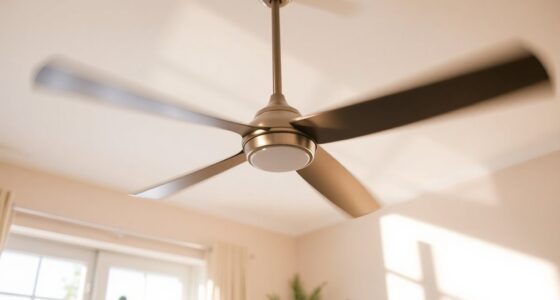Yes, suction pool cleaners are increasingly being replaced by robotic models as the preferred automated solution. Advances in technology, such as smarter navigation, remote control, and better efficiency, drive homeowners to choose robots for convenience and performance. While suction cleaners remain popular for their low upfront costs, robots offer long-term savings and better water cleaning. To understand how these trends could impact your pool maintenance, explore the latest market shifts and innovations.
Key Takeaways
- Automated robotic pool cleaners are increasingly favored for efficiency, reducing manual effort compared to traditional suction cleaners.
- Market trends show a decline in manual and basic suction cleaner sales, replaced by more advanced robotic and smart cleaning solutions.
- Robotic cleaners offer superior coverage, navigation, and customizable cleaning modes, giving them a competitive edge over suction units.
- Higher initial costs of robots are offset by lower long-term maintenance and repair expenses, boosting their market adoption.
- Regional and consumer preferences favor automation, with smart, autonomous cleaners overtaking traditional suction pool cleaning methods.
Evolution of Pool Cleaning Technologies Over the Years

The evolution of pool cleaning technologies has considerably improved how pools stay spotless and hygienic. In the past, manual maintenance was the primary method, requiring frequent scrubbing and skimming. Maintaining the pool chemical balance was a hands-on task, demanding constant testing and adjustment to prevent algae and bacteria growth. Over time, innovations introduced automated tools that simplified these chores. Early robotic cleaners offered basic debris removal, reducing manual effort. Today, advanced suction pool cleaners and robots work together to ensure thorough cleaning with minimal effort, while still supporting proper chemical balance. This progression has made pool maintenance more efficient, consistent, and accessible, allowing pool owners to enjoy cleaner, safer water without the exhaustive manual labor once needed. Additionally, integrating organized storage solutions can help homeowners keep their cleaning tools and accessories well-maintained and readily available. Moreover, the development of smart technology has enabled remote monitoring and control of cleaning devices, further enhancing user convenience and efficiency. The incorporation of advanced filtration systems has also played a key role in improving overall water quality and reducing the frequency of chemical adjustments. Furthermore, standardized operating hours across the industry have contributed to more predictable and reliable service schedules for pool maintenance. As technology continues to advance, user-friendly interfaces are increasingly common, making it easier for homeowners to operate and troubleshoot their cleaning devices.
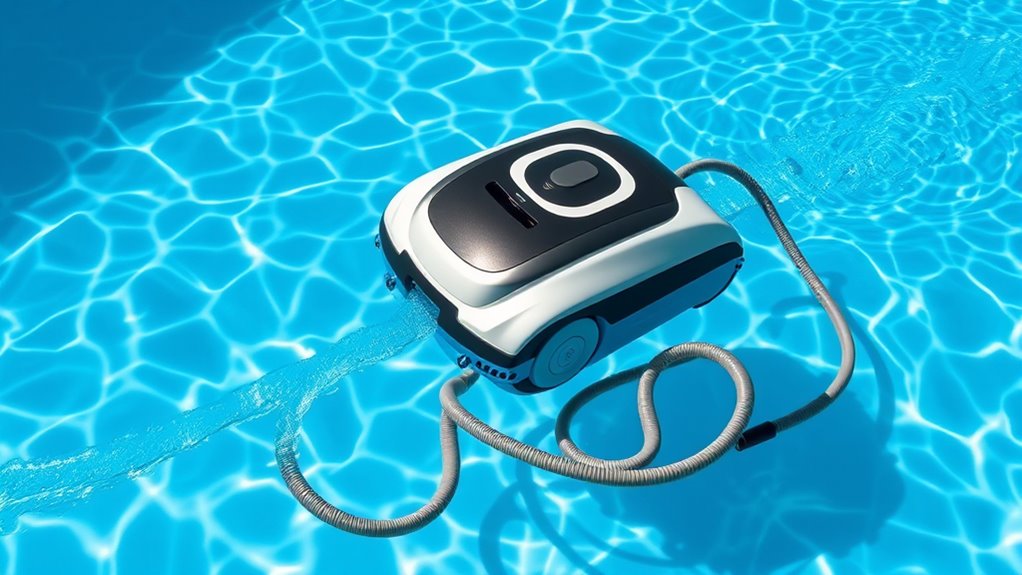
You’ve probably noticed more homeowners choosing automated pool cleaners over manual ones. As automation becomes more popular, manual units are steadily declining in sales. This shift signals a major change in how people maintain their pools today. Additionally, the rise of Volkswagen Tuning reflects a broader trend toward customized, performance-oriented solutions in automotive maintenance. The increasing adoption of automation in business underscores how technological advancements are transforming traditional maintenance practices across various industries. Such innovations contribute to the overall market share shifts, emphasizing the move toward more efficient, technology-driven solutions. Moreover, the adoption of budgeting techniques in managing household expenses demonstrates how strategic planning is also evolving alongside technological progress. The shift towards performance upgrades in vehicles illustrates how consumers are seeking personalized enhancements to improve their driving experience.
Rising Automation Adoption
As automation technology advances, more consumers are shifting away from traditional manual pool cleaning methods toward automated solutions like suction pool cleaners and robots. This trend reduces the need for manual maintenance and frequent pool skimming, saving you time and effort. Automated systems offer consistent cleaning, improved efficiency, and less reliance on manual labor. As market share shifts, you’ll notice a decline in manual units, making automated options more popular. The table below highlights key differences:
| Aspect | Manual Maintenance | Automated Solutions | Customer Benefits |
|---|---|---|---|
| Effort | High | Low | Less physical work |
| Consistency | Variable | Reliable | Regular, thorough cleaning |
| Cost | Lower upfront, ongoing labor | Higher initial, less ongoing | Time-saving, convenience |
| Pool skimming | Manual, time-consuming | Automated, efficient | Better water quality |
| Market Trend | Declining | Rising | Increased adoption |
Furthermore, efficiency in cleaning processes is a key factor driving the shift towards automated solutions. Additionally, the ongoing improvements in automation technology are making these devices more accessible and effective for a wider range of pool sizes and types. Moreover, advancements in hardware continue to enhance the durability and functionality of these automated cleaners, ensuring they remain a viable investment for homeowners.
Declining Manual Units
Automated pool cleaning solutions are rapidly gaining popularity, leading to a noticeable decline in manual units. As more homeowners embrace automation, manual maintenance becomes less common, and the number of traditional pool cleaners drops. This shift impacts your costs and effort, especially considering:
- Higher replacement costs for manual units due to wear and tear.
- Increased time spent on manual maintenance tasks.
- The convenience of automated systems reducing the need for frequent repairs.
- Long-term savings from fewer repairs and replacements.
With manual units fading, you’ll find that investing in robotic or suction pool cleaners offers better value, less hassle, and lower ongoing costs. This trend clearly shows the market moving away from manual solutions toward smarter, automated options.
Consumer Preferences and Adoption Rates of Robotic Cleaners

Are robotic pool cleaners gaining widespread popularity among consumers? Many customers now prioritize customer satisfaction, valuing ease of use and reliable performance. Positive experiences with robotic cleaners boost their adoption rates, especially when brands maintain strong reputations for quality and support. Consumers are increasingly attracted to the convenience and time-saving benefits these devices offer, often viewing them as a worthwhile investment. Brand reputation plays a vital role; trusted brands with proven track records tend to see higher adoption rates. As more users share their satisfaction, confidence in robotic cleaners grows, encouraging others to make the switch. Overall, consumer preferences are shifting towards robotic options, driven by the promise of efficiency, durability, and reputable brands that meet high customer expectations. Additionally, familiarity with brewing techniques and understanding how different cleaning devices operate can influence consumer choices and trust in product performance. For example, the rise of market trends indicates a broader shift towards automation and smart technology in household cleaning. Recognizing the importance of toilet maintenance and product reliability can further influence consumer confidence in adopting advanced cleaning solutions. Moreover, advancements in sound design can improve user experience by reducing operational noise, making these devices more appealing in household environments. Furthermore, ongoing research into AI security vulnerabilities highlights the need for manufacturers to develop safer and more secure robotic systems, which can enhance consumer trust in these devices.
Key Features and Innovations in Robotic Pool Cleaners
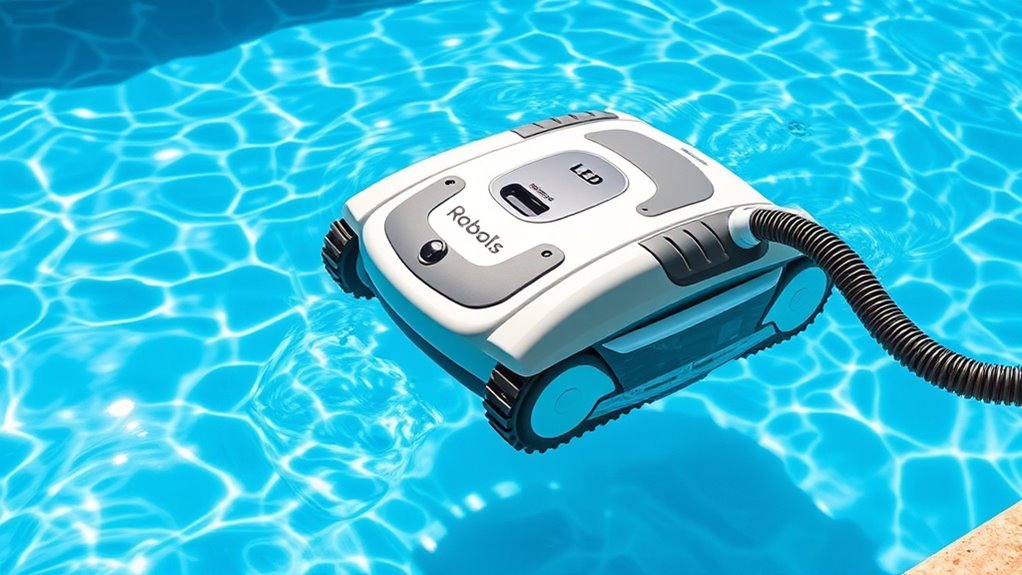
Robotic pool cleaners now come with advanced navigation systems that help them cover your entire pool efficiently. They offer enhanced cleaning modes to target specific debris and surfaces, making maintenance easier. Plus, smart connectivity features let you control and monitor your cleaner remotely for added convenience. Additionally, many models incorporate safety certifications that ensure reliable operation and durability over time. Incorporating advanced sensors further enhances their ability to detect obstacles and optimize cleaning paths, reducing the need for manual intervention. The integration of privacy policies ensures user data is handled securely during smart connectivity use.
Advanced Navigation Systems
Advanced navigation systems have revolutionized robotic pool cleaners by enabling them to move efficiently and thoroughly across pool surfaces. These systems incorporate smart features like:
- Mapping technology that creates a detailed layout of your pool, reducing missed spots. Mapping technology allows the cleaner to understand the entire pool environment, preventing redundant cleaning and ensuring comprehensive coverage. Additionally, mapping accuracy has improved with advanced sensors, leading to more precise navigation. The integration of advanced sensors enhances obstacle detection and path planning.
- Real-time obstacle detection to avoid furniture, ladders, and pool fixtures.
- Pattern algorithms that optimize cleaning paths, saving time and energy.
- Integration with app controls for remote monitoring, so you can adjust cleaning schedules without manual maintenance or pool chemical management concerns.
- Voice command compatibility allows users to control and schedule cleaning tasks conveniently through voice assistants.
With these features, your robotic cleaner does the hard work, minimizing manual intervention. This allows you to focus on other pool care tasks, ensuring your pool stays sparkling without the hassle of constant oversight.
Enhanced Cleaning Modes
Enhanced cleaning modes have introduced a new level of versatility and efficiency to robotic pool cleaners, allowing you to adapt to different pool conditions and cleaning needs. These modes enable the robot to switch between intensive scrubbing, quick cleans, or targeted spot cleaning, reducing manual maintenance efforts. With customizable cleaning schedules, you can set the robot to operate at specific times, ensuring consistent cleanliness without oversight. Some models automatically adjust cleaning intensity based on debris levels or pool size, optimizing performance. This innovation means you spend less time supervising and more time enjoying your pool. Additionally, advanced technology in robotic cleaners often includes sensors that detect dirt and obstacles, further enhancing their effectiveness. Overall, enhanced cleaning modes make robotic cleaners more flexible, effective, and user-friendly, setting them apart from traditional suction pool cleaners.
Smart Connectivity Features
Smart connectivity features have transformed robotic pool cleaners into more intuitive and convenient cleaning solutions. With these features, you can control your cleaner remotely, monitor its progress, and schedule cleanings via smartphone apps. Here are four key benefits:
- Real-time updates on cleaning status and water chemistry, helping you avoid manual maintenance surprises.
- Customizable cleaning schedules that adapt to your pool’s usage.
- Notifications for filter replacement or water chemistry issues, ensuring ideal operation.
- Remote troubleshooting and firmware updates to keep your cleaner running smoothly.
- The integration of advanced Vetted robotic components enhances durability and performance, ensuring your pool stays clean longer.
These innovations make managing your pool easier, reducing manual maintenance and keeping water chemistry balanced. Smart connectivity enables you to optimize cleaning efficiency and enjoy a cleaner, healthier pool with minimal effort.
Cost Analysis: Robotic vs. Suction Pool Cleaners

When comparing the costs of robotic and suction pool cleaners, it’s important to contemplate both upfront expenses and ongoing maintenance. Robotic cleaners typically have a higher initial cost but can save you money over time through efficient cleaning and reduced water and chemical use. Suction pool cleaners usually cost less upfront, making them attractive initially, but their maintenance expenses can add up, especially if parts need replacement or repairs are frequent. The cost comparison shows that robotic cleaners often require a larger upfront investment but may lower total maintenance expenses in the long run. Conversely, suction cleaners are more budget-friendly initially, but their ongoing maintenance might be more frequent and costly over time. Understanding these factors helps you make a smarter choice based on your budget and long-term needs.
Industry Expert Insights on Future Trends
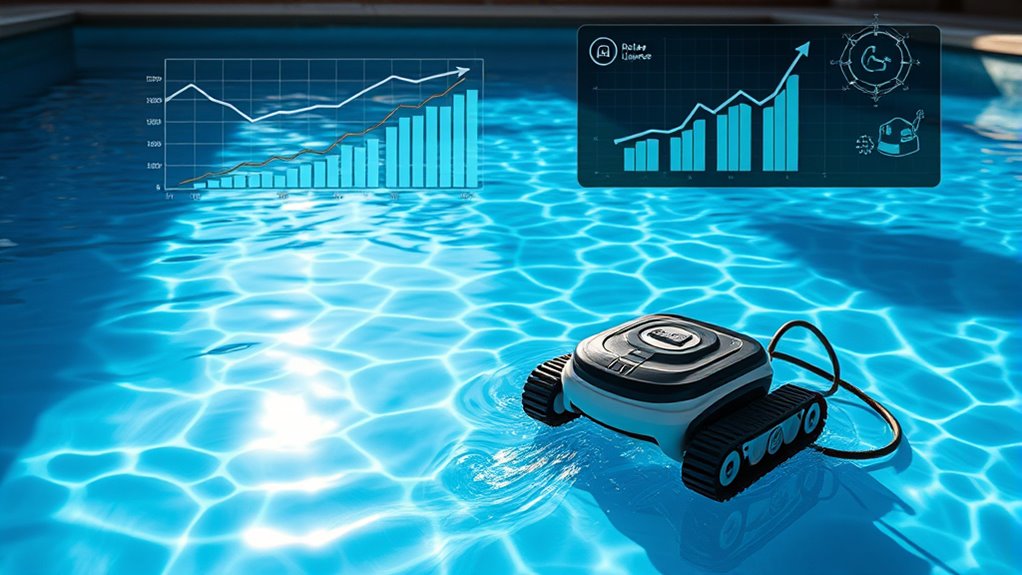
Industry experts predict that future developments in pool cleaning technology will focus on increasing automation, energy efficiency, and user convenience. To succeed, brands need strong market entry strategies that highlight innovation and reliability. Here are key trends to watch:
Future pool cleaning tech will prioritize automation, energy savings, and user-friendly features for market success.
- Enhanced autonomous features that adapt to pool sizes and shapes
- Integration with smart home systems for seamless control
- Improved battery life and faster charging times
- Brand reputation building through consistent quality and customer support
As these advancements emerge, your ability to differentiate through strategic market entry will be vital. Building a solid brand reputation now sets the foundation for future success, especially as consumers seek trustworthy, high-performance solutions. Staying ahead of industry trends ensures you remain competitive in this evolving market.
Environmental Impact and Energy Efficiency Considerations

As consumers become more environmentally conscious, the energy efficiency of pool cleaners and robots has taken on greater importance. Choosing devices that use less power helps reduce your carbon footprint and supports renewable energy initiatives. Many modern robotic pool cleaners are designed to operate with minimal energy, often incorporating energy-saving features that enhance water conservation. Some models even run on sustainable energy sources or integrate solar power, further lowering environmental impact. By selecting eco-friendly options, you contribute to water conservation efforts by reducing unnecessary energy consumption and waste. Overall, prioritizing energy efficiency not only benefits the environment but can also save you money on electricity and water bills. Your choices today shape a more sustainable pool cleaning future.
Challenges Faced by Robotic Pool Cleaners in Market Penetration
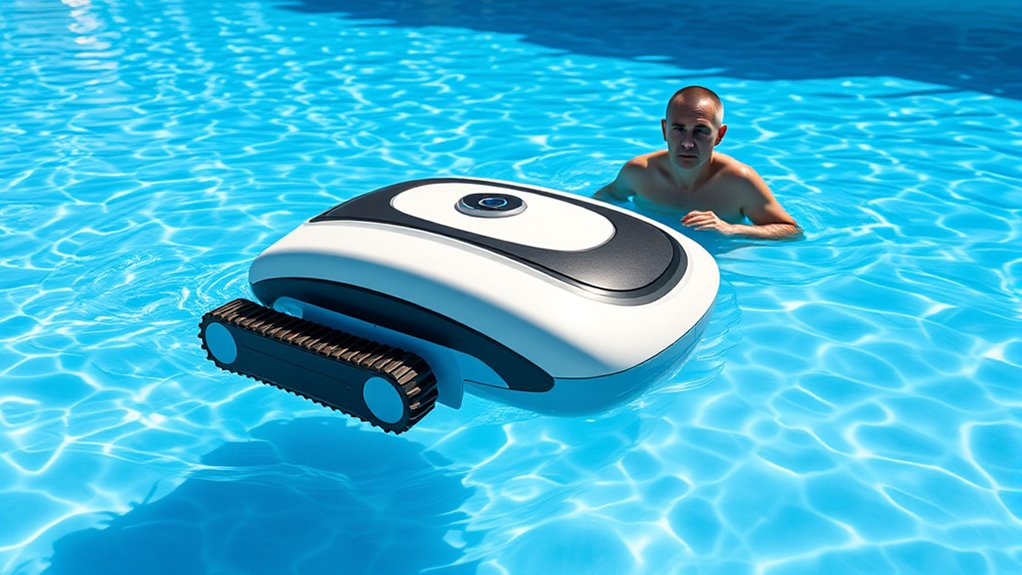
Despite the growing popularity of robotic pool cleaners, several challenges hinder their widespread adoption in the market. Technological barriers, such as limited battery life and navigation issues, reduce efficiency and consumer satisfaction. Additionally, low consumer awareness about the benefits and capabilities of robots slows market growth. To overcome these obstacles, consider these factors:
- High costs that deter budget-conscious buyers.
- Limited understanding of advanced features among consumers.
- Inconsistent performance across different pool sizes and types.
- Perceived reliability issues compared to traditional suction cleaners.
Addressing these challenges requires improving technology, increasing education, and demonstrating long-term savings. Until then, market penetration remains constrained despite the potential advantages of robotic pool cleaners.
Regional Variations in Pool Cleaning Technology Adoption

Regional differences play a significant role in how quickly and extensively pool cleaning technology, especially robotic cleaners, is adopted. In some regions, high disposable incomes and a focus on convenience drive faster regional adoption of advanced pool cleaning solutions. Cultural preferences also influence technology choices; for example, regions valuing automation and innovation tend to embrace robotic cleaners more readily. Conversely, areas with traditional approaches or budget constraints may favor simpler, cost-effective suction pool cleaners. Local climate and pool maintenance habits further shape adoption rates, with warmer regions seeing higher demand for automated cleaning. Understanding these regional variations helps you anticipate market shifts and tailor your offerings to meet specific cultural expectations and economic realities, ensuring better market penetration and customer satisfaction.
Predictions and Strategic Outlook for the Pool Cleaning Industry

The pool cleaning industry is poised for significant growth driven by technological advancements and shifting consumer preferences. Based on historical market analysis, the trend favors smarter, automated solutions. Your strategic outlook should focus on:
The pool cleaning industry is set for major growth through smarter, automated solutions driven by technological innovation.
- Embracing AI-powered robots that adapt to various pool types.
- Monitoring evolving consumer behavior towards convenience and eco-friendliness.
- Innovating with hybrid models combining suction and robotic features.
- Investing in data-driven insights to anticipate future demands.
As consumer expectations evolve, staying ahead means integrating emerging technologies and understanding changing preferences. The industry’s trajectory suggests increased adoption of autonomous systems, which will redefine market standards. Your ability to adapt strategies around these predictions will determine your competitive edge in this rapidly transforming landscape.
Frequently Asked Questions
How Do Robotic Pool Cleaners Compare in Lifespan to Suction Models?
Robotic pool cleaners often have a shorter lifespan than suction models, mainly because of battery life limitations. You might find that robots need more frequent repairs, which increases repair costs over time. Suction pool cleaners tend to last longer and require less maintenance, making them a more durable choice. If you’re prioritizing longevity, suction models generally outperform robotic cleaners in lifespan and affordability.
What Maintenance Is Required for Robotic vs. Suction Pool Cleaners?
Did you know robotic pool cleaners require about 20% less maintenance than suction models? When comparing maintenance, robotic cleaners need regular filter cleaning and software updates, while suction models mainly require checking hoses and ensuring proper chemical balance. Seasonal storage is also key; robotic units should be stored in a dry, cool place, whereas suction cleaners need to be dried and stored properly to prevent damage.
Are Robotic Pool Cleaners Suitable for All Pool Types and Sizes?
Robotic pool cleaners work well for most pool types and sizes, but you should consider your pool size and shape. For large or complex pools, select a robot with higher coverage and navigation features. Round pools are easier for robots to clean thoroughly, while irregular shapes may require models with advanced maneuverability. Overall, robotic cleaners are versatile, but choosing the right one depends on your specific pool size and shape.
How Do Robotic Cleaners Handle Complex Pool Shapes or Obstacles?
Robotic cleaners are quite effective at handling complex pool shapes, thanks to advanced navigation challenges and obstacle detection technology. They use sensors to detect walls, steps, and objects, adjusting their path to clean thoroughly. While some models may struggle with intricate designs or large obstacles, most modern robots adapt well, ensuring your pool gets cleaned efficiently without you needing to intervene. Their smart navigation makes them a reliable choice for diverse pool layouts.
What Safety Concerns Are Associated With Robotic Pool Cleaners?
When considering safety concerns with robotic pool cleaners, you should be aware of electrical safety risks, especially if the device isn’t properly grounded or insulated. You also need to watch out for chemical exposure, as chlorine and other chemicals can cause skin or respiratory irritation if leaks occur. Always follow manufacturer instructions, guarantee regular maintenance, and keep electrical components dry to minimize these hazards and enjoy a safer swimming experience.
Conclusion
As you watch robotic pool cleaners gain ground, it’s clear they’re redefining your pool maintenance. Did you know that robotic cleaners now hold over 40% of the market share, up from just 10% five years ago? This rapid growth highlights how innovative features and energy efficiency appeal to you. So, if you want a hassle-free swim experience, embracing robotic cleaners might just be the smart move for your pool’s future.




